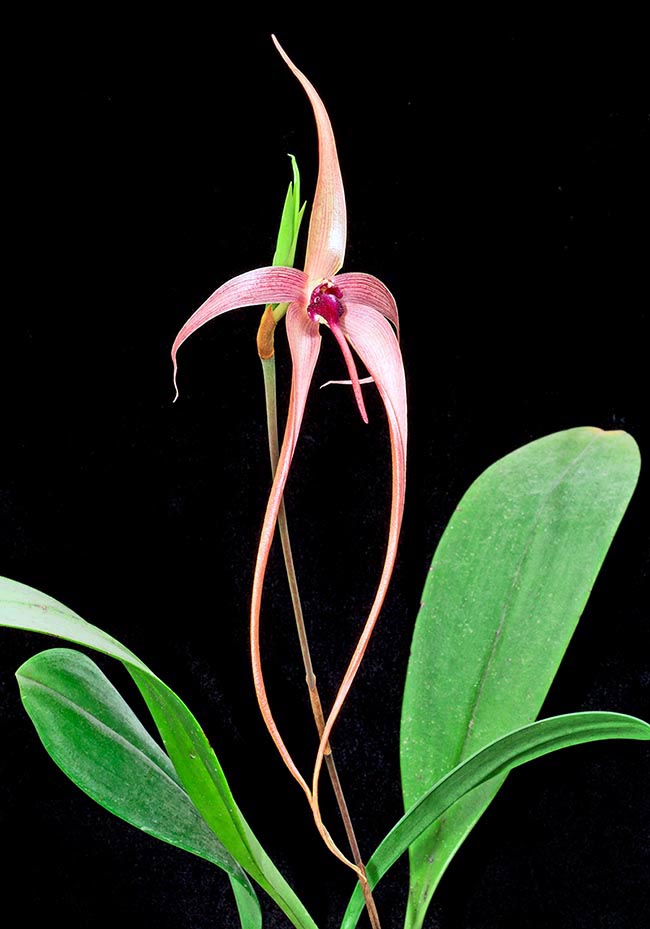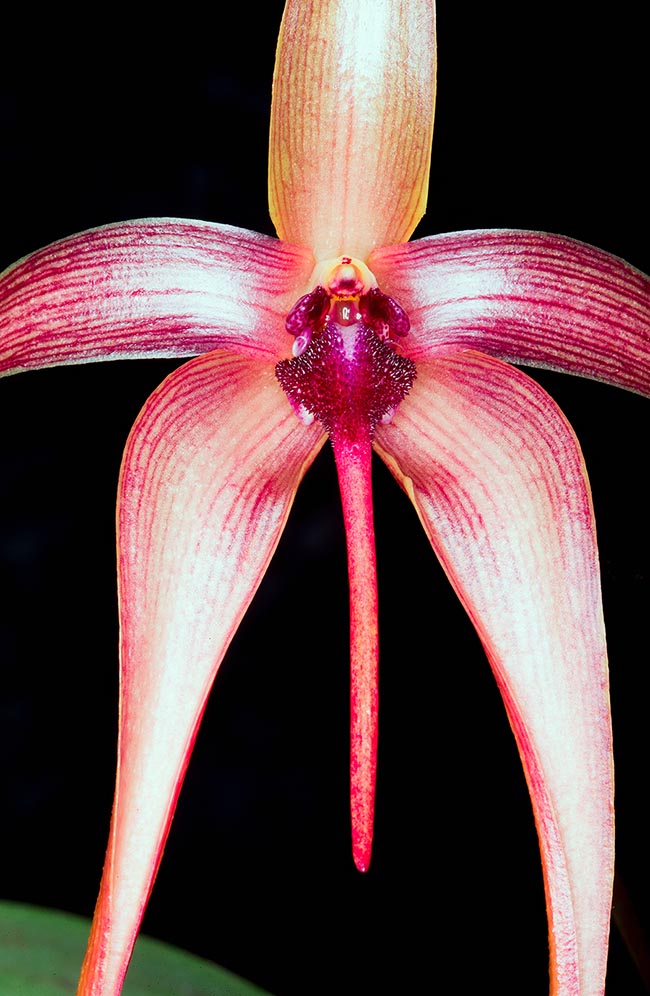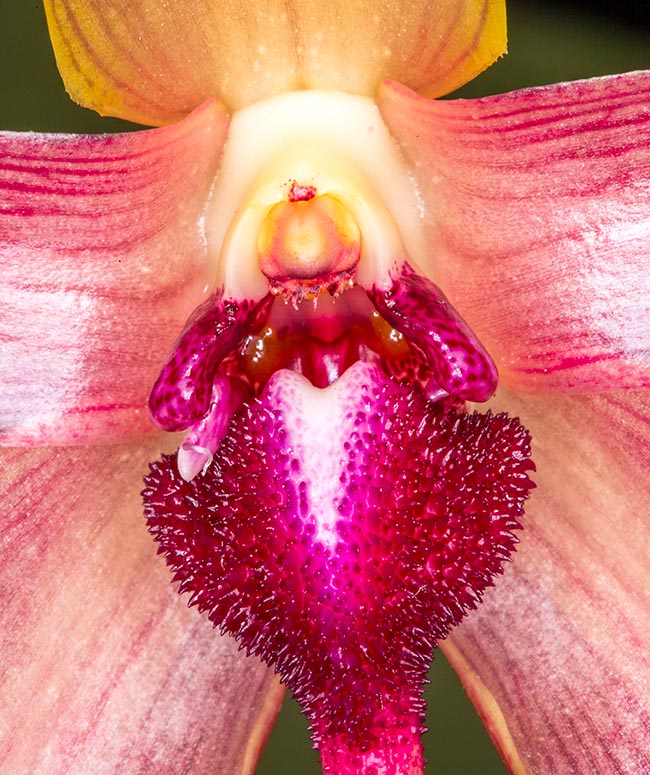Family : Orchidaceae

Text © Prof. Pietro Pavone

English translation by Mario Beltramini
Bulbophyllum echinolabium J.J.Sm., (1934) is a species of the family Orchidaceae, subfamily Epidendroideae, recently included in the tribe Malaxideae, subtribe Dendrobiinae.
Discovered near the city of Donggala (Central Sulawesi, Indonesia), has been described by the Dutch botanist Johannes Jacobus Smith (1867-1947) who, between 1905 and 1924, has crossed the islands of the Dutch East Indies (today(s Indonesia), in order to collect plants, orchids in particular, that he described upon his return to Holland, making a significant contribution to the knowledge of the flora of those territories.
Bulbophyllum echinolabium is a species endemic to Sulawesi Island and to Borneo, that grows as an epiphyte on the trees of the primary fluvial forests at an altitude between 600 and 1200 m.

Endangered in the wild, Bulbophyllum echinolabium has the largest flowers within the genus Bulbophyllum. In cultivation, they may exceed the 40 cm, about twice the length shown by J. Smith in its botanical description © Giuseppe Mazza
The name of the genus Bulbophyllum comes from the combination of the Greek “βολβός”(bilbos), meaning ‘bulb’ and “φύλλον” (phyllon), ‘leaf’, referring to the only one leaf the pseudobulbs of the plants have.
The specific epithet is of Latin derivation, formed by the union of “echinus” and “labium”, and refers to the verrucose labellum that looks like a sea urchin.
Known as Hedgehog-shaped lip bulbophyllum, it is a commercially protected species because in danger of extinction in nature and as such inserted in the Appendix II of Washington Convention (CITES) that has the purpose to protect the endangered animal and vegetal species, by preventing their export and possession.
It is a medium sized plant, with filiform roots suitable for creeping on the surface of the trees, at times hanging from the branches, with a rhizome from which, spced 1,8-3,5 cm, form egg-shaped pseudobulbs, not angular, up to 5 cm tall. Each pseudobulb carries only one leaf with petiole, fleshy and coriaceous, of elliptical to ovate shape, rounded at the apex, up to 20 cm long.
It is a species that in nature has a resting time due to the scarce rains during the winter months.
The photosynthesis of CAM type (Crassulacean Acid Metabolism), implemented as an adaptation to the excessive loss of water (xerophytic adaptation). In such a way the photosynthesis process takes place with closed stomata that, conversely, do open during the night for the gas exchanges (CO2, O2) with a minimum waste of water vapour.
From the rhizome, at the base of each pseudobulb, originates an inflorescence having a filiform scape, up to 70 cm long, and bears only one flower, rarely more. This species has the largest flower within the genus.
J. Smith, describing this species, reports 22 cm of length of the flower from the extremity of the dorsal petal up to the tips of the lateral petals, but, in cultivation, it has been noted that this length may reach 40 cm or even more.
The floral elements are pink, crimson in the veins, and orange in the distal part.
The dorsal sepal, seemingly reflected, has a convex and ovate base, getting gradually very long and narrow, with no apex. The lateral sepals have the apex slightly twisted and with an ovate-triangular base. The petals, inserted between the sepals, are small, lanceolate, gradually narrowed towards the apex. The labellum is mobile in order to facilitate the support of the pollinating insects with the proximal portion (hypochilus) curved, convex, and the distal one (epichile) linear. The labellum is verrucose and recalls the sea urchin.
The gynostemium is short, thick, with rounded anterior borders.

Epiphyte endemic to the primary fluvial forests of Sulawesi Island and of Borneo, where it grows between 600 and 1200 m of altitude, is pollinated by flies attracted by the putrid odor of the flower and by the colour of decaying meat © Giuseppe Mazza
The stigma is quadrangular, slightly widened towards the base, truncated, deeply grooved, with prominent margin. The base of the gynostemium forms with the ovary an obtuse angle. The ovary is obconic (having the apex downward), minutely dotted, about 1,3 cm long, with six grooves and supported by a smooth, 2,8 cm long, pedicel.
The flowers emit a putrid and pungent smell in a way to attract mainly flies. They also have glossy parts and a dark red to brown colour typical of rotting meat and of excrement. The insects are in such a way attracted to these flowers by deception (sapromophyly flowers) sure to find food and site suitable for the deposition of their eggs, but actually they only perform the rôle of pollinators.
Blooming takes place from March to September. The flowers keep open for about two weeks, but flowering is sequential and may last even months.
In cultivation this plant needs a level of light of 18000-30000 lux, therefore filtered light, never direct sunlight. The leaves, if exposed to the intense light, get dark red or brown, whilst, normally, in their natural environment they are of dark green colour. It is necessary to ensure a good movement of the air for the entire time of its growth.
It is a thermophilic plant that requires intermediate to warm temperatures, consequently, all over the year, it needs a night temperature of 16-25 °C and during the day of 18-30 °C, with a daily range of 7-8 °C. It requires also a constant humidity of about 80%.
The growth substratum must have excellent drainage and good air circulation around the roots. It is usually preferred to plant it in pots or small very flat baskets and with loose ground that can quickly dry up. It is suggested to add humectant additives, such as perlite or pieces of peat, mixed with a base material formed by small pieces of pine bark or of arboreal fern. The roots are very delicate and frail, it is necessary, therefore, to space out the repottings over time employing preferably the fibres of fern as these do not quickly decay as, conversely, occurs for the pine bark.
Bulbophyllum echinolabium must be abundantly irrigated during its growth but allowing the substratum to dry up between the irrigations, in order to avoid the dangerous water stagnation. During the winter, due to the reduced light, it is good to reduce the input of water. If the pseudobulbs begin to wrinkle, it is necessary to increase the waterings by the means of a spray thus to keep the air humidity in the order of 80%.
Fertilizations must be regular, with orchids fertilizer (usually one gram per litre) to be done once or twice per month. Fertilizations are to be suspended during the winter months (November-February).

The unusual hedgehog structure of the labellum gave name to the species. The CAM type photosynthesis typical to Crassulacean and other desert succulents allows bulbophylls with 20 cm leaves to overcome even long drought times © Giuseppe Mazza
By late winter the orchid emerges from its rest and therefore begins to grow again. therefore to the usual fertilizer can be added phosphorus and potassium for favouring the blooming.
Several hybrids do exist in trade that besides their vigour and the beauty of their flowers are easier to cultivate.
Among the primary hybrids we mention Bulbophyllum Jersey obtained in 1996 from crossing two species: Bulbophyllum lobbii Lindl. × Bulbophyllum echinolabium. The assigned name is the name of Jersey Island (English Channel) where this hybrid has been selected.
It is a vigorous plant, up to 25 cm tall, producing large flowers of about 18 cm of diametre with bright sepals in their many veins. The labellum is placed at the centre of the flower, typical of the genus, and is fairly small. The petals are neatly folded back.
The magenta yellow colours last about three weeks and are produced individually on hanging spikes that remain all summer. The plant produces rounded pseudobulbs with the rather thick only leaf. This hybrid requires temperatures intermediate. The substratum must be kept humid during the summer season, whilst in winter, when the plant is resting, the irrigations must be reduced. A good air movement is good for avoiding the growth of fungi.
Another very interesting primary hybrid, obtained in 2006, is Bulbophyllum Tonya Jacobs (Bulbophyllum facetum Garay × Bulbophyllum echinolabium). Its flower is big, 8×13 cm, with delicious reddish stripes on white-yellow-orange background and a nice mobile labellum.
The hybrid Bulbophyllum Bechinolina has been obtained by crossing between the very rare Bulbophyllum beccarii Rchb. f., with its big leaves and numerous small flowers (up to 150), with Bulbophyllum echinolabium. The outcome has been wonderful. The plant has amazing big and wide leaves. The flowers measure 8 cm of diametre, with large red veins, and get form sequentially on stems that may produce many of them (30-40) for a long time. The beauty of the flowers is in contrast with their smell that recalls the carrions.
Many other hybrids do exist obtained not from single species but from hybrids. As an example, Bulbophyllum ‘Hannah Freel’ has been realized by B. Thoms, in 2020, by crossing between Bulbophyllum echinolabium × Bulbophyllum ‘Manchind’, this last in its turn has been obtained by B. Thoms in 2011 between Bulbophyllum mandibulare Rchb.f. × Bulbophyllum echinolabium.
